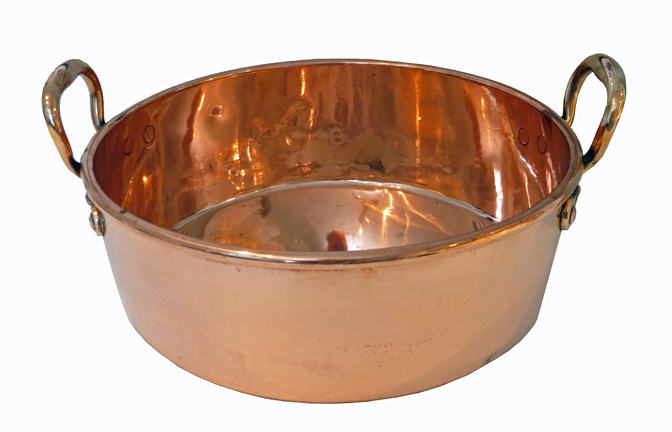
Nothing says summer more than the fragrance and taste of just-picked fresh fruit. The first strawberry of the season, the sweetness of raspberries, lush, liquid cherries… Delicious now, more cherished still in the dead of winter–when the taste of jam takes you back to these precious/fleeting days of Summer. Now, while we’re in the thick of it, you need to be making preserves. And we have what will make it a success, solid copper jam pans.
First, the basics. You won’t find a better heat conductor anywhere. That means you’ll spend less time boiling away the fruit’s flavor, color and texture. Then there is the shallowness and slightly flared sides. The first makes stirring easier and provides a little more space in which the syrupy mass can boil up without boiling over. The second helps moisture evaporate; it doesn’t run back into the mixture as with vertical sides–thus letting you create a more intense jam flavor. And, of course, the wide pan lets the incredible fruit fragrances fill your kitchen–the unmistakable perfume of summer.
Now for the fun stuff.
- It is said that Joan of Arc would always eat quince jam before a battle to give her courage.
- Without Crusaders bringing the “newly discovered spice” sugar back from the Middle East, we wouldn’t have jam today.
- By 1319, sugar finally arrived in the London markets. The cost? Over $50.00 per pound.
- Louis XIV served jam on silver trays at the conclusion of his royal feasts. Each guest was provided with a silver spoon with which they could sample the newly-introduced delicacy.
- By 1890, jam was de-rigueur at English tea-time, spread on toast and accompanied by another newly arrived delicacy, peanut butter.
Make your own lucious strawberry balsamic jam. For rave reviews, contact us for a simple recipe.
Antique Copper French Jam Pan
Date/Circa: 1890
Size: 5″ high with 15″ diameter
Date/Circa: 1890
Size: 5″ high with 15″ diameter
